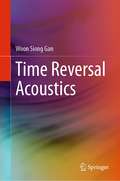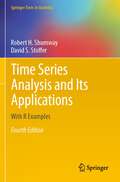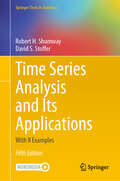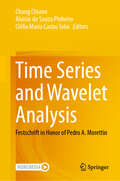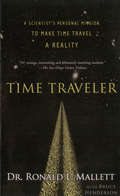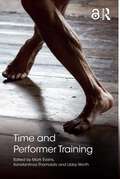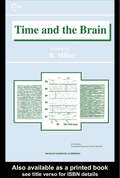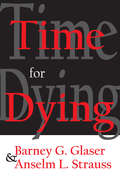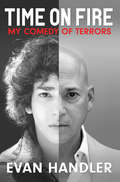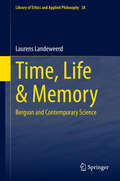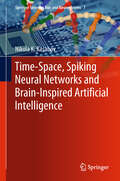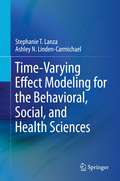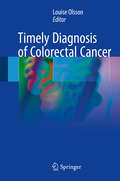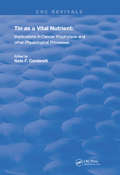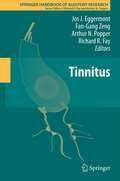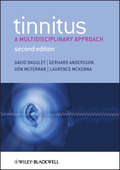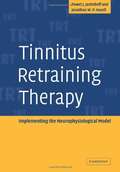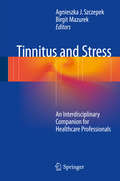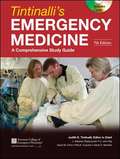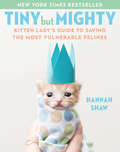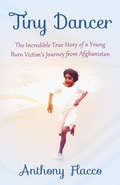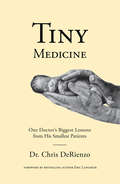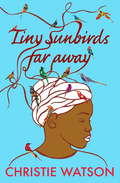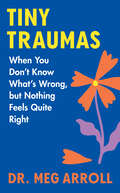- Table View
- List View
Time Reversal Acoustics
by Woon Siong GanThis book highlights time reversal acoustics, techniques based on the symmetry properties of acoustic fields. It has the unique feature that the first eleven chapters of the book are on the indepth studies of the theories of time reversal acoustics. The remaining chapters are on the four major applications of time reversal acoustics, together with their experimental setups and case studies: underwater communication, seismic exploration,nondestructive evaluation, and medical ultrasound imaging.. The gauge invariance approach to acoustic fields, proposed by the author in 2007, is confirmed by the successful fabrication of acoustical metamaterials and the applications of time reversal acoustics to superresolution. The book also presents groundbreaking applications of time reversal acoustics to underwater communication technology and the application of metamaterials to time reversal acoustics.
Time Series Analysis and Its Applications: With R Examples (Springer Texts in Statistics)
by Robert H. Shumway David S. StofferThe fourth edition of this popular graduate textbook, like its predecessors, presents a balanced and comprehensive treatment of both time and frequency domain methods with accompanying theory. Numerous examples using nontrivial data illustrate solutions to problems such as discovering natural and anthropogenic climate change, evaluating pain perception experiments using functional magnetic resonance imaging, and monitoring a nuclear test ban treaty.The book is designed as a textbook for graduate level students in the physical, biological, and social sciences and as a graduate level text in statistics. Some parts may also serve as an undergraduate introductory course. Theory and methodology are separated to allow presentations on different levels. In addition to coverage of classical methods of time series regression, ARIMA models, spectral analysis and state-space models, the text includes modern developments including categorical time series analysis, multivariate spectral methods, long memory series, nonlinear models, resampling techniques, GARCH models, ARMAX models, stochastic volatility, wavelets, and Markov chain Monte Carlo integration methods.This edition includes R code for each numerical example in addition to Appendix R, which provides a reference for the data sets and R scripts used in the text in addition to a tutorial on basic R commands and R time series. An additional file is available on the book’s website for download, making all the data sets and scripts easy to load into R.
Time Series Analysis and Its Applications: With R Examples (Springer Texts in Statistics)
by Robert H. Shumway David S. StofferThis 5th edition of this popular graduate textbook presents a balanced and comprehensive treatment of both time and frequency domain methods with accompanying theory. It includes numerous examples using nontrivial data illustrate solutions to problems such as discovering natural and anthropogenic climate change, evaluating pain perception experiments using functional magnetic resonance imaging, and monitoring a nuclear test ban treaty. The R package ‘astsa’ has had major updates and the text will reflect those updates. In general, the graphics have been improved. New topics include random number generation, modeling and fitting predator-prey interactions, more emphasis on structural models, testing for linearity, discussion of EM algorithm is more extensive, Bayesian analysis of state space models and MCMC is more extensive (including new scripts in astsa), particle methods are introduced, stochastic volatility coverage is expanded, changepoint detection is introduced (new topic). The book is designed as a textbook for graduate level students in the physical, biological, and social sciences and as a graduate level text in statistics. Some parts may also serve as an undergraduate introductory course. Theory and methodology are separated to allow presentations on different levels. In addition to coverage of classical methods of time series regression, ARIMA models, spectral analysis and state-space models, the text includes modern developments including categorical time series analysis, multivariate spectral methods, long memory series, nonlinear models, resampling techniques, GARCH models, ARMAX models, stochastic volatility, and Markov chain Monte Carlo integration methods. This edition includes R code for each numerical example.
Time Series and Wavelet Analysis: Festschrift in Honor of Pedro A. Morettin
by Chang Chiann Aluisio de Souza Pinheiro Clélia Maria Castro ToloiProf. Pedro A. Morettin is a Distinguished Professor of Statistics at the Institute of Mathematics and Statistics of the University of São Paulo (IME-USP), where he has built an academic career spanning almost six decades. His work has had a significant impact on Time Series Analysis and Wavelet Statistical Methods, as exemplified by the papers appearing in this Festschrift, which are authored by renowned researchers in both fields. Besides his long-term commitment to research, Prof. Morettin is very active in mentoring and serving the profession. Moreover, he has written several textbooks, which are still a leading source of knowledge and learning for undergraduate and graduate students, practitioners, and researchers. Divided into two parts, the Festschrift presents a collection of papers that illustrate Prof. Morettin’s broad contributions to Time Series and Econometrics, and to Wavelets. The reader will be able to learn state-of-the-art statistical methodologies, from periodic ARMA models, fractional Brownian motion, and generalized Ornstein-Uhlenbeck processes to spatial models, passing through complex structures designed for high-dimensional data analysis, such as graph and dynamic models. The topics and data features discussed here include high-frequency sampling, fNRIS, forecasting, portfolio apportionment, volatility assessment, dairy production, and inflation, which are relevant to econometrics, medicine, and the food industry. The volume ends with a discussion of several very powerful tools based on wavelets, spectral analysis, dimensionality reduction, self-similarity, scaling, copulas, and other notions.
Time Traveler: A Scientist's Personal Mission to Make Time Travel a Reality
by Bruce Henderson Ronald L. MallettThis is the dramatic and inspirational first-person story of theoretical physicist, Dr. Ronald Mallett, who recently discovered the basic equations for a working time machine that he believes can be used as a transport vehicle to the past. Combining elements of Rocket Boys and Elegant Universe, Time Traveler follows Mallett's discovery of Einstein's work on space-time, his study of Godel's work on a solution of Einstein's equation that might allow for time travel, and his own research in theoretical physics spanning thirty years that culminated in his recent discovery of the effects of circulating laser light and its application to time travel. The foundation for Mallett's historic time-travel work is Einstein's theory of general relativity, a sound platform for any physicist. Through his years of reading and studying Einstein, Mallett became a buff well before he had any notion of the importance of the grand old relativist's theories to his own career. One interesting subtext to the story is Mallett's identification with, and keen interest in, Einstein. Mallett provides easy-to-understand explanations of the famous physicist's seminal work.
Time and Performer Training
by Mark Evans Libby Worth Konstantinos ThomaidisTime and Performer Training addresses the importance and centrality of time and temporality to the practices, processes and conceptual thinking of performer training. Notions of time are embedded in almost every aspect of performer training, and so contributors to this book look at: age/aging and children in the training context how training impacts over a lifetime the duration of training and the impact of training regimes over time concepts of timing and the ‘right’ time how time is viewed from a range of international training perspectives collectives, ensembles and fashions in training, their decay or endurance. Through focusing on time and the temporal in performer training, this book offers innovative ways of integrating research into studio practices. It also steps out beyond the more traditional places of training to open up time in relation to contested training practices that take place online, in festival spaces and in folk or amateur practices. Ideal for both instructors and students, each section of this well-illustrated book follows a thematic structure and includes full-length chapters alongside shorter provocations. Featuring contributions from an international range of authors who draw on their backgrounds as artists, scholars and teachers, Time and Performer Training is a major step in our understanding of how time affects the preparation for performance.
Time and the Brain (Conceptual Advances in Brain Research)
by Ian MuehlenhausSince the days of Galileo, time has been a fundamental variable in scientific attempts to understand the natural world. Once the first recordings of electrical activity in the brain had been made, it became clear that electrical signals from the brain consist of very complex temporal patterns. This can now be demonstrated by recordings at the singl
Time for Dying
by Graham McAleerThis book has been written for those who must work with and give care to the dying. Our discussion is not simple narrative or description; it is a ""rendition of reality,"" informed by a rather densely woven and fairly abstract theoretical scheme. This scheme evolved gradually during the course of our research. The second audience for this volume is social scientists who are less interested in dying than they are in useful substantive theory. Our central concern is with the temporal aspects of work. The theory presented here may be useful to social scientists interested in areas far removed from health, medicine, or hospitals. The training of physicians and nurses equips them for the technical aspects of dealing with illness.Medical students learn not to kill patients through error, and to save lives through diagnosis and treatment. But their teachers put little or no emphasis on how to talk with dying patients; how-or whether-to disclose an impending death; or even how to approach the subject with the wives, husbands, children, and parents of the dying. Students of nursing are taught how to give nursing care to terminal patients, as well as how to give ""post-mortem care."" But the psychological aspects of dealing with the dying and their families are virtually absent from training. Although physicians and nurses are highly skilled at handling the bodies of terminal patients, their behavior to them otherwise is actually outside the province of professional standards. Much, if not most, nontechnical conduct toward, and in the presence of, dying patients and their families is profoundly influenced by ""common sense"" assumptions, essentially untouched by professional or even rational considerations or by current advancement in social-psychological knowledge. The process of dying in hospitals is much affected by professional training and codes, and by the particular conditions of work generated by hospitals as places of work. A third important consideration in int
Time on Fire
by Evan HandlerBased on Evan Handler's hit off-Broadway play (called by The New York Times "laceratingly funny and self-revealing"), Time on Fire is a remarkable memoir of illness and survival, love and hope-shot through with anger, humor, and piercing eloquence.Evan Handler was twenty-four and already an accomplished actor when he was diagnosed with acute leukemia and told that his chances for survival were slim. Resigning his role in Neil Simon's Biloxi Blues, Handler checked into New York Memorial's Cancer Center and began a bizarre, sometimes uproarious five-year journey in and out of hospitals-"a raucous rump through Hell"-only to face an equally arduous return to the life he left behind.Time on Fire is the story of Handler's passage into a twilight world: a place of lonely, haunting despair lit by moments of exultation and hilarity; a world where the truly horrible and the hysterically funny not only coexist but seem to become the same thing. Told with the trenchant humor of a survivor, it takes a wry, unflinching look at the absurdity of fighting for life in a place where death is what is most expected, and a health care system on the brink of madness. It is the story of refusing to succumb to the pressures of conformity that threatened his recovery and of the fierce struggle to find the road back to health-at all costs.From the comic accounts of his trip to a Madison Avenue sperm bank ("Nothing but the best address for my progeny") and his experimentation with psychic healing, to the portrayal of the unraveling effects of his illness on his family and girlfriend, Handler records with astonishing precision the full emotional range of his experience. The result is a bracing, achingly poignant account of his determination to steal time and reclaim life. Glowing with uncommon insights and uncompromising honesty, Time on Fire is a testament to the bravery and the endurance of the human spirit.
Time, Life & Memory: Bergson and Contemporary Science (Library of Ethics and Applied Philosophy #38)
by Laurens LandeweerdThis book revitalizes the relevance of the ideas of Henri Bergson (1859-1941) for current developments in exact sciences. It explores the relevance of Bergson's thought for contemporary philosophical reflections on three of the most important scientific research areas of today, namely physics, the life sciences and the neurosciences. It does so on the basis of the three interrelated topics of time, life and memory. Henri Bergson (1859-1941) was one of the most widely read philosophers of his era. The European public was seeking for answers to questions of the soul and the nature of life and fitting within a historical niche between intellectual rationalism and intuitive spiritualism, his writings drew much attention. This work focuses on the relevance of his philosophy for developments in exact sciences today. The discussion of physics in relation to the abstract and the concrete, the life sciences in relation to concepts of life in relation to new and emerging biotechnology, and the neurosciences in relation to the dual nature of human identity, focuses on one main topic: time. Time, isolated from experience, as the measure of the events in the universe in modern physics; time as the measure of emergent systems in evolution as the backdrop of the theory of evolution in biology; time in relation to memory and imagination in neuropsychological accounts of memory. The author thus discusses the ideas of Henri Bergson as a basis to unveil time as a living process, rather than as an instrument for the measure of events. This view forms the basis of a novel approach to the philosophy of technology. An exciting book for academics interested in the interplay between hard sciences and philosophy.
Time-Space, Spiking Neural Networks and Brain-Inspired Artificial Intelligence (Springer Series on Bio- and Neurosystems #7)
by Nikola K. KasabovSpiking neural networks (SNN) are biologically inspired computational models that represent and process information internally as trains of spikes. This monograph book presents the classical theory and applications of SNN, including original author’s contribution to the area. The book introduces for the first time not only deep learning and deep knowledge representation in the human brain and in brain-inspired SNN, but takes that further to develop new types of AI systems, called in the book brain-inspired AI (BI-AI). BI-AI systems are illustrated on: cognitive brain data, including EEG, fMRI and DTI; audio-visual data; brain-computer interfaces; personalized modelling in bio-neuroinformatics; multisensory streaming data modelling in finance, environment and ecology; data compression; neuromorphic hardware implementation. Future directions, such as the integration of multiple modalities, such as quantum-, molecular- and brain information processing, is presented in the last chapter. The book is a research book for postgraduate students, researchers and practitioners across wider areas, including computer and information sciences, engineering, applied mathematics, bio- and neurosciences.
Time-Varying Effect Modeling for the Behavioral, Social, and Health Sciences
by Stephanie T. Lanza Ashley N. Linden-CarmichaelThis book is the first to introduce applied behavioral, social, and health sciences researchers to a new analytic method, the time-varying effect model (TVEM). It details how TVEM may be used to advance research on developmental and dynamic processes by examining how associations between variables change across time. The book describes how TVEM is a direct and intuitive extension of standard linear regression; whereas standard linear regression coefficients are static estimates that do not change with time, TVEM coefficients are allowed to change as continuous functions of real time, including developmental age, historical time, time of day, days since an event, and so forth.The book introduces readers to new research questions that can be addressed by applying TVEM in their research. Readers gain the practical skills necessary for specifying a wide variety of time-varying effect models, including those with continuous, binary, and count outcomes. The book presents technical details of TVEM estimation and three novel empirical studies focused on developmental questions using TVEM to estimate age-varying effects, historical shifts in behavior and attitudes, and real-time changes across days relative to an event. The volume provides a walkthrough of the process for conducting each of these studies, presenting decisions that were made, and offering sufficient detail so that readers may embark on similar studies in their own research. The book concludes with comments about additional uses of TVEM in applied research as well as software considerations and future directions. Throughout the book, proper interpretation of the output provided by TVEM is emphasized.Time-Varying Effect Modeling for the Behavioral, Social, and Health Sciences is an essential resource for researchers, clinicians/practitioners as well as graduate students in developmental psychology, public health, statistics and methodology for the social, behavioral, developmental, and public health sciences.
Timely Diagnosis of Colorectal Cancer
by Louise OlssonThis book summarizes current knowledge and outlines directions for the future on how to improve the art of diagnosing colorectal cancer with emphasis on timeliness, one of the most vital issues in cancer management. Using a comprehensive, multi-discliplinary approach, it provides an overview of decisive factors in timely diagnosis of colorectal cancer from symptom scores and symptom awareness to technical aspects. The book starts by discussing early diagnosis from the perspective of patients, including the importance of awareness in the general population as well as psychological aspects. It then goes on to discuss issues of importance to clinicians, such as fast tracking, laboratory testing, improving technical skills and optimizing endoscopy services. In addition, more practical issues such as cost-effectiveness and auditing are also extensively discussed. By focusing on one specific but common form of cancer the content translates well across the scope of other cancer types and can be used by professionals working on different cancer types. This book provides clinicians, clinical researchers and policymakers with a comprehensive overview of the field of timeliness in diagnosing colorectal cancer. By addressing the challenges posed in the management of symptomatic patients it informs and educates the experts and could help improve diagnosis.
Tin as a Vital Nutrient: Implications in Cancer Prophylaxis and other Physiological Processes (Routledge Revivals)
by Nate F. CardarelliFirst published in 1986. Taken from the Tin and Cell Malignancy Symposium, this volume will help others to appreciate the interdisciplinary nature of this field.
Tinnitus
by Arthur N. Popper Richard R. Fay Fan-Gang Zeng Jos J. EggermontTinnitus is a prevalent hearing disease, affecting 15% of the population, particularly hearing impaired, veterans and even young people who grow up with mp3 players and iPods. The mechanisms underlying tinnitus remain controversial. At present there is no cure for tinnitus, and treatment options are limited. Different from previous tinnitus books, including A. R. Moller's book [in press at Springer], which typically have a strong clinical flavor, the present volume focuses on neural mechanisms of tinnitus and its behavioral consequences. The proposed book starts with a general summary of the field and a short introduction on the selection and content of the remaining chapters. Chapter 2 overviews tinnitus prevalence and etiologies to set the tone for significance and complexity of this neurological disorder spectrum. Chapters 3-8 cover neuroscience of tinnitus in animal models from molecular mechanisms to cortical manifestation. Chapters 9-12 cover human brain responses to tinnitus and it clinical management.
Tinnitus
by Don Mcferran David Baguley Laurence Mckenna Gerhard AnderssonTinnitus: A Multidisciplinary Approach provides a broad account of tinnitus and hyperacusis, detailing the latest research and developments in clinical management, incorporating insights from audiology, otology, psychology, psychiatry and auditory neuroscience. It promotes a collaborative approach to treatment that will benefit patients and clinicians alike.The 2nd edition has been thoroughly updated and revised in line with the very latest developments in the field. The book contains 40% new material including two brand new chapters on neurophysiological models of tinnitus and emerging treatments; and the addition of a glossary as well as appendices detailing treatment protocols for use in an audiology and psychology context respectively.
Tinnitus Retraining Therapy
by Pawel J. Jastreboff Jonathan W. P. HazellTinnitus retraining therapy is Pawel J. Jastreboff's clinical implementation of his neurophysiological model of tinnitus, which conceptualizes tinnitus as a neural signal that can have varying effects on the central nervous system. Otolaryngologists explain how to counsel patients to use it, covering the neural and learning principles, assessment, and treatment. Suggestions for initial and follow-up interviews, and patient take-home reminders are also provided. Any clinician can conduct the counseling, but audiologists tend to have the optimal background and equipment. Annotation ©2007 Book News, Inc. , Portland, OR (booknews. com)
Tinnitus and Stress
by Agnieszka Szczepek Birgit MazurekThis book provides up-to-date scientific information on the pathways by which psychosocial stress can affect the auditory system and describes current approaches to the management of patients with stress-related tinnitus. The latest evidence is presented on aspects such as the role of stress hormones in auditory function, the effects of allostatic load, circadian sensitivity to auditory trauma, and the association between stress-related biomarkers and tinnitus. The clinically oriented chapters discuss psychometric instruments of value in the tinnitus clinic and present stress-related tinnitus treatment protocols and outcome measures. It is widely acknowledged that the tinnitus percept acts as a stressor. However, it is also now evident that psychosocial stress can play a causative role in tinnitus and that the impact varies according to the level, duration, and quality of the stress. Assessment of the types and levels of stress in tinnitus patients before, during, and after treatment is therefore very important. Healthcare professionals attending tinnitus patients will benefit from the information that this book provides on the relationship between tinnitus and stress and from the practical guidance that it offers.
Tintinalli's Emergency Medicine: A Comprehensive Study Guide (7th Edition)
by O. John Ma Rita K. Cydulka J. Stephan Stapczynski Judith E. Tintinalli David M. Cline Garth D. MecklerWith 418 contributors representing over 120 medical centers around the world, Tintinalli''s Emergency Medicine is the most practical and clinically rigorous reference of its kind. It covers everything from prehospital care, disaster preparedness, and basic resuscitative techniques, to all the major diseases requiring emergency treatment, such as pulmonary emergencies, renal and GU disorders, and hemophilia. This authoritative, in-depth coverage makes this classic text indispensible not only in emergency departments, but also for residents and practitioners when studying or preparing for any exam they may face. While continuing to provide the most current information for acute conditions, the Seventh Edition of Tintinalli''s Emergency Medicine has been substantially revised and updated to cover all of the conditions for which patients seek emergency department care in a concise and easy-to-read-manner.
Tiny But Mighty: Kitten Lady's Guide to Saving the Most Vulnerable Felines
by Hannah Shaw*A New York Times Bestseller* #1 National BestsellerIndie BestsellerFrom Kitten Lady, the professional kitten rescuer, humane educator, animal advocate, and owner of the popular Instagram @kittenxlady comes the definitive book on saving the most vulnerable—and adorable—feline population: newborn kittens.Hannah Shaw, better known as Kitten Lady, has dedicated her life to saving the tiniest felines, but one doesn't have to be a professional kitten rescuer to change—and save—lives. In Tiny but Mighty, Hannah not only outlines the dangers newborn kittens face and how she combats them, but how you can help every step of the way, from fighting feline overpopulation on the streets to fostering unweaned kittens, from combating illness to combating compassion fatigue, from finding a vet to finding the purrfect forever home. Filled with information on animal welfare, instructional guides, and personal rescue stories of kittens like Chloe, Tidbit, Hank, and Badger—not to mention hundreds of adorable kitten photos—Tiny but Mighty is the must-have kitten book for cat lovers, current-and-future rescuers, foster parents, activists, and advocates.
Tiny Dancer: The Incredible True Story of a Young Burn Victim's Journey from Afghanistan
by Anthony FlaccoThe astonishing story of a brave little girl from Afghanistan who not only survived horrific disfiguring burns, but was given a second chance at life. Tiny Dancer is the amazing true story of Zubaida Hasan, a nine-year-old girl from the remote deserts of Afghanistan, who, in the summer of 2001, accidentally fell into a kerosene fire while heating water for a bath. Though she was horribly mutilated, her father refused to give up and exhaustively sought help to save his child. When an American Green Beret soldier by chance sees Zubaida and her father on the street, he decides he must get involved. With assistance from many members of the US military, little Zubaida is given a second chance at life. She is flown to Los Angeles to begin a two-year journey through a series of surgeries performed by famed burn surgeon Dr. Peter Grossman. He and his wife, Rebecca, eventually take the child into their own home. This is a heartfelt and inspiring story of incredible courage equally matched by incredible kindness. “Flacco’s depiction of Zubaida’s culture shock is remarkable. [His] empathy and ability to tell Zubaida’s story like he’s inside her head makes for an engrossing feel-good read.” —Publishers Weekly “Interesting and affecting. . . . [A] genuinely moving story.” —Booklist
Tiny Medicine: One Doctor's Biggest Lessons from His Smallest Patients
by Eric Langshur Chris DeRienzoEvery year, nearly 4 million babies are born in the United States. Most arrive safely and go home with their families in a matter of days. But not all babies come into the world healthy and almost half a million arrive well before they are expected. These newborns need tiny medicine. Told from the first-person perspective, Dr. Chris DeRienzo—a neonatologist, health system leader and frequent keynote speaker—walks readers through the human experience of caring for the world's smallest and sickest patients. His stories share the absurd and the sublime parts of being a doctor and detail how they have shaped who he is as a husband, father, and person. Readers will learn the secrets of the NICU, the loneliness that comes with life and death decisions, and the incredibly powerful sense of purpose and triumph that comes with just making it through the night and keeping everyone alive. In the end, this book delivers an insider's view of a doctor's life never before accessible without a white coat.
Tiny Sunbirds Far Away: From the author of The Courage to Care and The Language of Kindness, winner of Costa First Novel Award
by Christie WatsonWINNER OF THE COSTA FIRST NOVEL AWARD, BY THE BESTSELLING AUTHOR OF THE LANGUAGE OF KINDNESS AND THE COURAGE TO CARE'Everything changed after Mama found Father lying on top of another woman.' Blessing and her brother Ezikiel adore their larger-than-life father, their glamorous mother and their comfortable life in Lagos. But all that changes when their father leaves them for another woman. Their mother is fired from her job at the Royal Imperial Hotel - only married women can work there - and soon they have to quit their air-conditioned apartment to go and live with their grandparents in a compound in the Niger Delta.Adapting to life with a poor countryside family is a shock beyond measure after their privileged upbringing in Lagos. Told in Blessing's own beguiling voice, Tiny Sunbirds Far Away shows how some families can survive almost anything. At times hilarious, always poignant, occasionally tragic, it is peopled with characters you will never forget.
Tiny Sunbirds Far Away: Winner of the Costa First Novel Award, from the author of The Language of Kindness
by Christie WatsonWINNER OF THE COSTA FIRST NOVEL AWARD. 'Everything changed after Mama found Father lying on top of another woman.' Blessing and her brother Ezikiel adore their larger-than-life father, their glamorous mother and their comfortable life in Lagos. But all that changes when their father leaves them for another woman. Their mother is fired from her job at the Royal Imperial Hotel - only married women can work there - and soon they have to quit their air-conditioned apartment to go and live with their grandparents in a compound in the Niger Delta. Adapting to life with a poor countryside family is a shock beyond measure after their privileged upbringing in Lagos. Told in Blessing's own beguiling voice, Tiny Sunbirds Far Away shows how some families can survive almost anything. At times hilarious, always poignant, occasionally tragic, it is peopled with characters you will never forget.(P)2012 Quercus Editions Ltd
Tiny Traumas: When You Don't Know What's Wrong, but Nothing Feels Quite Right
by Meg ArrollPsychologist Dr. Meg Arroll offers a much-needed framework for recognizing and combatting the devastating cumulative effects of small everyday wounds—“tiny traumas”—that, like major traumas, can negatively shape our lives.Have you ever felt at a loss for an answer when asked: ‘How are you really feeling?” Maybe you can’t quite put your finger on it, but you know something is definitely off. Microaggressions, challenging family relationships, toxic positivity, work and pandemic stress, gaslighting—these are just a few examples of what psychologist Dr. Meg Arroll calls “Tiny T” trauma. These tiny traumas can slowly build up inside of us, and if ignored for too long, can manifest in our lives as high-functioning anxiety, perfectionism, binge eating, insomnia, broken relationships, and a host of other problems. While advice on healing from major trauma is plentiful, there is little guidance available to help us recover from these “smaller” yet emotionally devastating traumas that are common to all of us. Now, Dr. Meg fills that gap and helps us find peace with this revolutionary guide.In Tiny Traumas, Dr. Meg introduces her three-step AAA approach that allows us to start understanding and healing from these tiny traumas:Awareness: discover your unique constellation of tiny traumasAcceptance: see how these tiny traumas show up in your life and start processing themAction: start taking the steps to actively create the life you desireTiny Traumas teaches readers how to recognize and address past experiences so we can overcome the lasting pain and detrimental effects and truly start living the happier, more peaceful lives we deserve.
